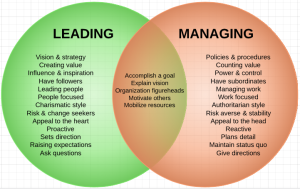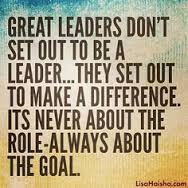 Those of you who collaborate or cooperate regularly with teachers, who introduce new technology resources, and who use your library website and social media to promote your program are being leaders. Many more of you are doing much of this in smaller ways but are too intimidated by the word “leader” to apply it yourself. There is a tendency to think of the “big names” in our field, and perhaps the visible members of your state library association as leaders (which they are), but don’t believe the label applies to you.
Those of you who collaborate or cooperate regularly with teachers, who introduce new technology resources, and who use your library website and social media to promote your program are being leaders. Many more of you are doing much of this in smaller ways but are too intimidated by the word “leader” to apply it yourself. There is a tendency to think of the “big names” in our field, and perhaps the visible members of your state library association as leaders (which they are), but don’t believe the label applies to you.
It does. You have all the elements needed to be a leader but must accept the role and recognize how you are showing it in order to fully take on that challenge. You self-perception affects how others see you.
To get past having to assume the somewhat daunting title of leader, start with Manager. Managing is one aspect of leadership and you are likely to feel more comfortable in developing and displaying that skill set first. Managing has to do with working with groups, building consensus, and working toward a common goal.
If you have volunteers, you definitely want to manage them. While they may initially come to see their child, they will stick around and do a better job if they feel valued and know their time produces worthwhile results. Share your Mission Statement (you should have one) with them and explain how their work contributes to it. Acknowledge them on your website. Where possible give them jobs to match their talents. They can do displays, help with photos or videos of students in action, or even take on a section of the library collection tied to their personal interest.
Building relationships with teachers requires managing ability. All of them need to know you are there to work with them and help them achieve their objectives. Common Core gives you an easy unifying goal, but you can also focus on a smaller scale such as ensuring students develop Enduring Understandings as a learning out of a unit.
Serving on building or district committees is another opportunity for managing, even if you aren’t chairing it. Using your Emotional Intelligence (see the blog from July 13), you can ease any tensions, help build consensus, and share your expertise without bringing any ego to the table. You probably would have done all these things but, being aware of what a manager does reminds you of this role you have in the educational community and makes it easier for you to recognize you are a leader.
I don’t want to suggest that Managing is the same as Leading. It’s just easier to take on the title of Leader once you have accepted you are a Manager. Leaders make decisions, take risks, and propose a vision for the future. When others develop respect for you as a manager, it simplifies the transition to full leader.
 Building confidence as a manger helps ready you to take risks such as proposing a new program. You have support from faculty members who trust you and have seen your expertise in action. The administration knows you are a team player has confidence in your ability to get the job done. Now you can create the exciting vision of where you want your library program to go, have a plan for getting it there, and know many are ready to help you achieve it.
Building confidence as a manger helps ready you to take risks such as proposing a new program. You have support from faculty members who trust you and have seen your expertise in action. The administration knows you are a team player has confidence in your ability to get the job done. Now you can create the exciting vision of where you want your library program to go, have a plan for getting it there, and know many are ready to help you achieve it.
Baby steps are all you need to do to get started. Just put one foot in front of the other. Trust and believe in yourself.
